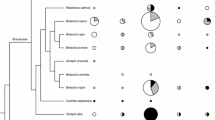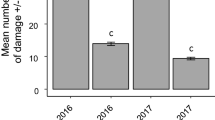Abstract
Pollen beetle (Meligethes aeneus F.) (PB) causes very serious problems in oilseed rape (Brassica napus var. oleifera L.) cultivations in Poland and other European countries. Pyrethroid insecticides are the most frequently used type for controlling PB in Poland. This chemical group has been used in Poland since the beginning of the 1980’s and its strong selection pressure on PB resulted in some level of resistance of this pest to many active substances. The aim of this investigation was to analyze, with the use of synergists, the main mechanisms responsible for resistance of PB to pyrethroids. The results indicate the main resistance factor in Polish PB populations to be monooxygenase enzymes.

Similar content being viewed by others
References
Abbott, W. S. (1925). A method of computing the effectiveness of an insecticide. Journal of Economic Entomology, 18, 265–267.
Brattsten, L. B. (1979). Biochemical defense mechanisms in herbivores against plant allelochemicals. In G. A. Rosenthal & D. H. Janzen (Eds.), Herbivores: Their interaction with secondary plant metabolites (pp. 200–270). New York, NY: Academic Press.
Casida, J. E. (1970). Mixed-function oxidase involvement in the biochemistry of insecticide synergists. Journal of Agricultural and Food Chemistry, 18, 753–772.
Clark, A. G. (1986). Insecticide metabolism by multiple glutathione S-transferases in two strains of the house fly, Musca domestica (L.). Pesticide Biochemistry and Physiology, 25, 169–175.
Dowd, P. F., Smith, C. M., & Sparks, T. C. (1983). Detoxification of plant toxins by insects. Insect Biochemistry, 13, 453–468.
Farnham, A. W. (1973). Genetics of resistance of pyrethroid-selected houseflies, Musca domestica (L.). Pesticide Science, 4, 513–520.
Field, L. M., & Devonshire, A. L. (1992). Esterase gene conferring insecticide resistance in aphids. In C. A. Mullen, & J. G. Scott (Eds.), Molecular mechanisms of insecticide resistance (pp. 209–217). ACS symposium series 505. Washington, DC: American Chemical Society
Finney, D. J. (1952). Probit analysis. A statistical treatment of the sigmoid response curve, vol. 2 (pp. 236–245). London, UK: Cambridge University Press.
Fournier, D., & Mutero, A. (1994). Modification of acetylcholinesterase as a mechanism of resistance to insecticides. Comparative Biochemistry and Physiology Part C, 108, 19–31.
Gunning, R. V., Moores, G. D., & Devonshire, A. L. (1998). Inhibition of resistance related esterases by piperonyl butoxide in Helicoverpa armigera and Aphis gossypii. In D. G. Jones (Ed.), Piperonyl butoxide, the insecticide synergist (pp. 215–226). London, UK: Academic Press.
Heimbach, U., Müller, A., & Thieme, T. (2006). First steps to analyse pyrethroid resistance of different oilseed rape pests in Germany: an extended abstract. IOBC wprs Bulletin, 29(7), 131–134.
Ishaaya, I. (1993). Insect detoxifying enzymes: their importance in pesticide synergism and resistance. Archives of Insect Biochemistry and Physiology, 22, 263–276.
Ishaaya, I. (Ed.). (2001). Biochemical sites of insecticide action and resistance. Berlin, Germany: Springer-Verlag.
Lund, A. E. (1984). Pyrethroid modification of sodium channel: current concepts. Pesticide Biochemistry and Physiology, 22, 161–168.
Malinowski, H. (1987). Spektrum odporności krzyżowej owadów selekcjonowanych fotostabilnymi pyretroidami na przykładzie muchy domowej (Musca domestica L.). [The range of cross-resistance at insects selected with photostabile pyrethroids on the example of Musca domestica (L.).]. Roczniki Nauk Rolniczych [Annales of Agricultural Sciences] E, 17(1), 119–132.
Malinowski, H. (1988). Badania nad Odpornością Owadów na Fotostabilne Pyretroidy na Przykładzie Muchy Domowej (Musca domestica L.). [Research on insects’ resistance to photostable pyrethroids on the example of Musca domestica (L.)]. Warsaw, Poland: Instytut Przemysłu Organicznego [Institute of Industrial Organic Chemistry].
Malinowski, H. (2000). Fizjologiczne, biochemiczne i behawioralne mechanizmy odporności owadów na insektycydy chemiczne. [Physiological, biochemical and behavioural insect resistance mechanisms to chemical insecticides]. Prace Instytutu Badawczego Leśnictwa [Forest Research Institute], A, 1(892), 7–43.
Malinowski, H. (2003). Odporność owadów na insektycydy. [Insects resistance to insecticides]. Warsaw, Poland: Wydawnictwo Wieś Jutra Publishers.
Moores, G. D., Philippou, D., Borzatta, V., Trincia, P., Jewess, P., Gunning, R., et al. (2009). An analogue of piperonyl butoxide facilitates the characterisation of metabolic resistance. Pest Management Science, 65, 150–154.
Mrówczyński, M. (2003). Studium nad doskonaleniem ochrony rzepaku ozimego przed szkodnikami. [Research on the improvement of rapeseed protection against pests]. Poznan, Poland: Rozprawy Naukowe Instytutu Ochrony Roślin [Scientific Papers of the Institute of Plant Protection].
Naumann, K. (1990). Action of pyrethroids against arthropod pests. In G. Haug & H. Hoffmann (Eds.), Chemistry of plant protection 4. Synthetic pyrethroid insecticides: structures and properties (pp. 87–115). Berlin, Germany: Springer-Verlag.
Obrępalska-Stęplowska, A., Węgorek, P., Nowaczyk, K., & Zamojska, J. (2006). The study on pyrethroid resistance in pollen beetle Meligethes aeneus. Acta Biochemica Polonica, 53, 198–199.
Richardson, D. M. (2008). Summary of findings from a participant country pollen beetle questionnaire. EPPO Bulletin, 38, 68–72.
Różański, L. (1992). Przemiany pestycydów w organizmach żywych i w środowisku. [Pesticides transformations in live organisms and in the environment]. Warsaw, Poland: National Agricultural and Forest Publishers.
Sawicki, R. M., Farnham, A. W., Denholm, I., & Church, V. J. (1985). Potentiation of super-kdr resistance to deltamethrin and other pyrethroids by an intensifier (factor 161) on autosome 2 in the housefly (Musca domestica L). Pesticide Science, 4, 501–512.
Schoknecht, U., & Otto, D. (1989). Enzymes involved in the metabolism of organophosphorus, carbamate and pyrethroid insecticides. In G. Haug & H. Hoffmann (Eds.), Chemistry of plant protection 2. Degradation of pesticides, desiccation, and defoliation, ACh-receptors as targets (pp. 118–149). Berlin, Germany: Springer-Verlag.
Silcox, C. A., Ghidiu, G. M., & Forgash, A. J. (1985). Laboratory and field evaluation of piperonyl butoxide as pyrethroid synergist against Colorado potato beetle. Journal of Economic Entomology, 78, 1399–1405.
Tozzi, A. (1998). A brief history of the development of piperonyl butoxide as an insecticide synergist. In D. G. Jones (Ed.), Piperonyl butoxide: The insecticide synergist (pp. 1–5). San Diego, CA, USA: Academic Press.
Węgorek, P. (2009). Badania nad odpornością chrząszczy słodyszka rzepakowego (Meligethes aeneus F.) na insektycydy. [Research on pollen beetle (Meligethes aeneus F.) resistance to insecticides.]. Rozprawy Naukowe IOR – PIB [Scientific Papers of the Institute of Plant Protection – National Research Institute], 20. Poznan, Poland.
Węgorek, P., Mrówczyński, M., & Zamojska, J. (2009). Resistance of pollen beetle (Meligethes aeneus F.) to selected active substances of insecticides in Poland. Journal of Plant Protection Research, 49, 119–127.
Węgorek, P., Obrępalska-Stęplowska, A., Nowaczyk, K., & Zamojska, J. (2007). The level of resistance of Polish populations of pollen beetle (Meligethes aeneus F.) against pyrethroids; mechanisms of resistance in light of molecular research. Progress in Plant Protection Research, 47, 383–388.
Wilkinson, C. F. (1983). Role of mixed-function oxidases in insecticide resistance. In G. P. Georghiou & T. Saito (Eds.), Pest resistance to pesticides (pp. 175–206). New York, NY: Plenum Press.
Yasutomi, K. (1983). Role of detoxication esterases in insecticide resistance. In G. P. Georghiou & T. Saito (Eds.), Pest resistance to pesticides (pp. 249–263). New York, NY: Plenum Press.
Young, S. J., Gunning, R. V., & Moores, G. D. (2005). The effect of PBO on pyrethroid-resistance-associated esterases in Helicoverpa armigera (Hübner) (Lepidoptera: Noctuidae). Pest Management Science, 61, 397–401.
Author information
Authors and Affiliations
Corresponding author
Rights and permissions
About this article
Cite this article
Węgorek, P., Zamojska, J. & Mrówczyński, M. High resistance to pyrethroid insecticides in the Polish pollen beetle (Meligethes aeneus F.): the role of oxidative metabolism. Phytoparasitica 39, 43–49 (2011). https://doi.org/10.1007/s12600-010-0138-0
Received:
Accepted:
Published:
Issue Date:
DOI: https://doi.org/10.1007/s12600-010-0138-0




